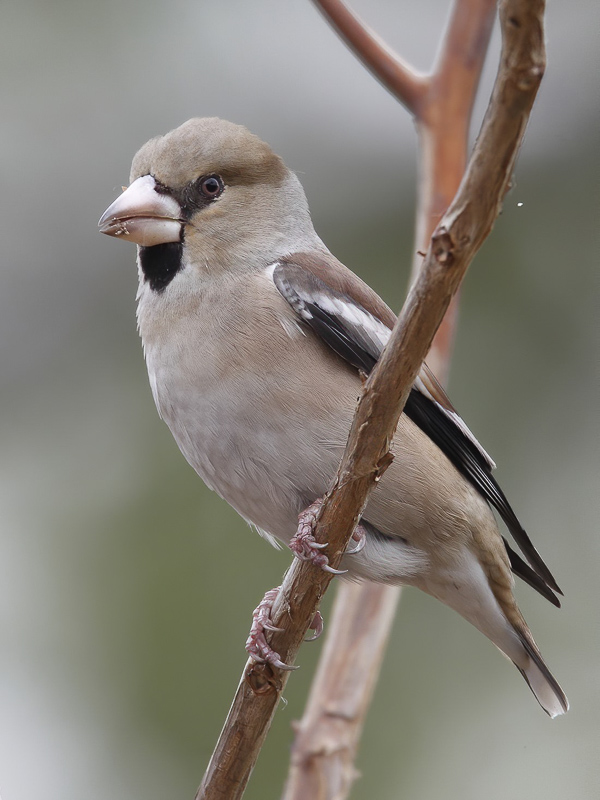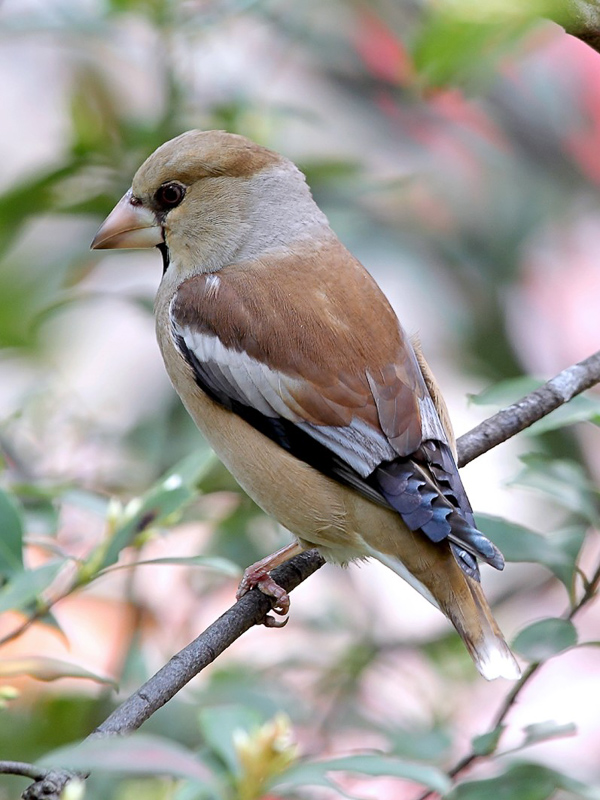Hawfinch Coccothraustes coccothraustes 錫嘴雀
Category I. Accidental.
IDENTIFICATION

Mar. 2011, Martin Hale.
16-18 cm. Large, stocky, short-tailed and large-billed finch with broad-based triangular wings. Buff-brown overall with a black mask and throat. Fairly broad white tip to tail. Dull pale pinkish bill in non-breeding season.

Mar. 2011, Michelle and Peter Wong. Female.
Greyish hindneck contrasting with brown mantle, pale outer and buff brown inner scapulars, dark remiges and wing coverts with broad pale bases to inner webs of primaries visible in flight. Greyish secondaries and narrow black loral patch indicate female.
VOCALISATIONS
Clement et al. (1993) note that the call is a sharp and abrupt ‘tik’ or ‘tzik’, uttered singly or in pairs both in flight and when perched.
It also gives a shrill ‘tzee’ or ‘tzeeep’. The call is often the first indication of the presence of this species.
DISTRIBUTION & HABITAT PREFERENCE
Has occurred in lowland open country areas in the northern New Territories.
OCCURRENCE
There are eight records of birds considered to be of natural origin from 1 November to 6 March:
1984: one at Mong Tseng on 26 December and 5 January 1985.
1994: one at Mui Wo 17 November.
2006: one at Mong Tseng 22 January.
2009: one at Shek Kong 14 - 23 January, one at Ping Che on 19 February.
2011: two at Yuen Long 21 to 23 February, one at Ping Long, Lam Tsuen 24 February to 6 March.
2012: one on Po Toi on 1 November.
BEHAVIOUR, FORAGING & DIET
Birds have been seen perched prominently in trees, sometimes after being flushed from where they were foraging out of sight on or near the ground.
RANGE & SYSTEMATICS
Breeds in western Europe and northwest Africa east through most of Europe, western Russia and southern parts of Central Asia to northeast China, Ussuriland, Japan, Kamchatka and Sakhalin. Some movement to winter in milder areas occurs, particularly in east Asia. In China, breeds in northeast provinces to Hebei and winters in southeast China; breeds also in northern Xinjiang (Liu and Chen (2020).
HK records are presumed to refer to C. c. shulpini, which breeds in southeast Siberia, northeast China and Korea; however, it is possible that C. c. japonicus is involved (Liu and Chen 2020), which breeds in the Kamchatka Peninsula, Sakhalin, Kuril Islands and Japan. Four other subspecies are recognised, though the differences are slight.
CONSERVATION STATUS
IUCN: Least Concern. Population trend increasing.
Clement, P., A. Harris and J. Davis. (1993). Finches and Sparrows. An Identification Guide. Christopher Helm, A. & C. Black, London.
Liu, Y. and Y. H. Chen (eds) (2020). The CNG Field Guide to the Birds of China (in Chinese). Hunan Science and Technology Publication House.

